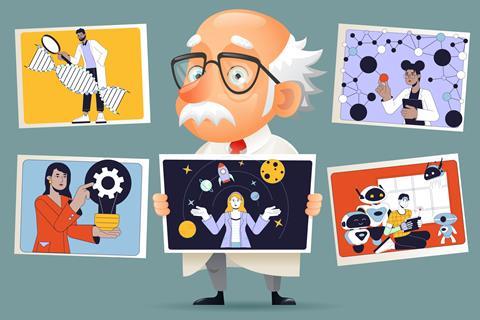Why is the stereotype of a ‘typical’ scientist alive and well in 2025?
In 1957 anthropologists sought to discover what high school students would draw if they asked them to create an image of a ‘typical’ scientist. The result was a white man wearing glasses and a white laboratory coat, surrounded by scientific equipment. Imagine my disappointment when, almost 70 years later, we conducted the same test and only five out of 200 educators who took part in the activity drew women.

To explore this stereotypical image, David Wade Chambers developed the Draw a scientist test (Dast) and thousands of children have taken part. Analysis of five decades of Dast showed that although most learners still draw scientists as men, the proportion has reduced from 99% to 73%.
Interestingly, recent US-based studies have shown the age of the learner impacted the drawing, with the majority of six year-olds drawing a scientist who mirrored their own gender. This is reflected in studies from other nations too, such as Science and scientists from children’s point of view (Italy) and Images of chemical scientists through Turkish primary students’ eyes. However, data from the long-term analysis showed that this viewpoint changed as the pupils get older until, by age 16, the majority of Dast entries were men scientists. I wonder what experiences at school or home contributed to this change?
In 1957 anthropologists sought to discover what high school students would draw if they asked them to create an image of a ‘typical’ scientist. The result was a white man wearing glasses and a white laboratory coat, surrounded by scientific equipment (bit.ly/3Dv3jfm). Imagine my disappointment when, almost 70 years later, we conducted the same test and only five out of 200 educators who took part in the activity drew women.
To explore this stereotypical image, David Wade Chambers developed the Draw a scientist test (Dast) and thousands of children have taken part (bit.ly/4igJiru). The development of children’s gender–science stereotypes analysis of five decades of Dast showed that although most learners still draw male scientists, the proportion has reduced from 99% to 73% (bit.ly/3DHk8DQ).
Interestingly, recent US-based studies have shown the age of the learner impacted the drawing, with the majority of six year-olds drawing a scientist who mirrored their own gender. This is reflected in studies from other nations too, such as Italy’s Science and scientists from children’s point of view (bit.ly/41B6HNJ) and Images of chemical scientists through Turkish primary students’ eyes (bit.ly/43x22qK). However, data from the long-term analysis showed that this viewpoint changed as the pupils get older until, by age 16, the majority of Dast entries were male scientists. I wonder what experiences at school or home contributed to this change?
So, nearly 70 years after the first publication, myself and colleagues from the RSC Education team considered what perceptions exist, and what adults would draw today. We used Draw a scientist as a starter activity at our Introduction to RSC teacher support workshops, giving our attendees one minute to draw as part of our events. The results were stark. From nearly 200 participants, only five drew women scientists and although some drew gender-neutral scientists (around 10%), this was down to limited drawing skills rather than being deliberate.
It also made me think, what would I have drawn?
We found these results very disappointing. I worry that learners think a science career isn’t for them because they can’t see someone of their gender in that role. Even when a group of primary teachers shared experiences with the fantastic STEM organisations that also support them over the years, they all drew Einstein-like figures. Undoubtedly personal experiences make a positive impact, however. When we asked one student teacher, who had not studied science past GCSE, ‘Why did you draw a woman?’, they replied: ‘I have a scientist friend who is always talking about her job.’ I thought it was fabulous that there was someone so passionate about their job that they wanted to talk about it. But still, it was only one in 200.
However, it also made me think, what would I have drawn? Before becoming a secondary school science teacher, I was a research scientist for nearly a decade, working in a chemistry lab, wearing a white lab coat and safety specs every day – it was my uniform. I was surrounded by intricate glassware, colourful compounds and on occasions wisps of liquid nitrogen. If someone had drawn a cartoon version of me, I would have looked very similar to the stereotype, except my gender.
A Future in Chemistry
Find job profiles, videos, posters and more on our careers website to smash stereotypes.
Scientist is a catch-all job title, so is it any wonder we see people drawing such stereotypes? When researchers asked young children to draw other professions, 70% drew teachers as women, followed by 53% of veterinarians. But only 31% of scientists they drew were women. If we take the Cambridge dictionary’s definition of a scientist as ‘an expert who studies or works in one of the sciences’, then a veterinarian is one. It also made me question what would images of other professions look like, for example a historian?
Changing perceptions
Scientist is a catch-all job title, so is it any wonder we see people drawing such stereotypes? When researchers asked young children to draw other professions, 70% drew teachers as women, followed by 53% of veterinarians. But only 31% of scientists they drew were women (bit.ly/4hpuKFg). If we take the Cambridge dictionary’s definition of a scientist as ‘an expert who studies or works in one of the sciences’, then a veterinarian is one. It also made me question what would images of other professions look like, for example a historian?
Yes, I am still disappointed that in our small sample size the pale, male scientist in a white lab coat with crazy hair stereotype still predominates, but it also gave us a chance to have great conversations. It allowed all of us to challenge our preconceptions about what an actual scientist does and what scientists look like. Yes, the stereotype still exists, but used as a starting point to share examples of real people who just happen to be scientists, we can turn it around and show learners that scientists look just like them.
Rebecca Laye is an RSC education coordinator in Wales














No comments yet